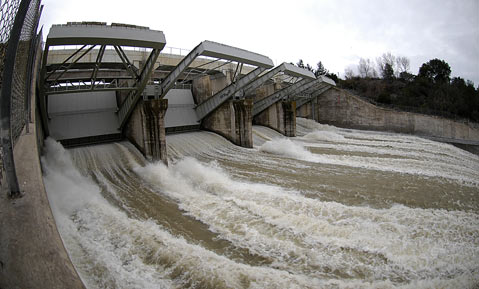State Water Glass 5 Percent Full
Storm Clouds Loom over Long-Term Supply

— shown spilling on January 10, 2005 — will have to be set aside to create spawning habitat for the federally endangered steelhead trout.
With local officials bracing for rains that threaten to match the El Niño deluges of 1982 and 1992, it’s surprising to learn that long-term water supplies for the South Coast may be facing some serious challenges. Last week, the Santa Barbara City Council was notified by city water czar Rebecca Bjork that state water officials have agreed to provide no more than 5 percent of the 3,300 acre-feet of water entitlements for which the City of Santa Barbara pays $4 million a year. That’s dramatically less than anytime in the past 10 years. Last year, for example, the state delivered 40 percent of its subscribed entitlements to local water agencies.
The shortfall stems from chronic water shortages caused by four years of sub-standard snowfall. If dire predictions about global warming’s effect on California hold true, this lack of snowpack could pose a serious long-term problem. In addition, environmental concerns about endangered smelt in the San Francisco Bay Delta — shredded in large numbers by the massive, sucking turbines required to transport fresh water from Northern California to the south — show little signs of being resolved.
Until the Delta issues are resolved, the amount of potable drinking water the State Water Project can reliably deliver remains open to serious doubt. For water planners at City Hall, these issues are both serious and academic. That’s because the City of Santa Barbara has rarely asked for more than half the water to which it’s “entitled.” State Water, after all, was only designed to provide a supplemental water supply. If City Hall has never used that much State Water in the first place, how can the city miss it that much when it’s no longer available?
But for ratepayers, it’s another story. They pay the same for State Water whether City Hall gets none or all 3,300 acre-feet. (That’s because most of the $4 million in annual charges pays for the bonds sold to pay construction costs for the vast infrastructure of pipes, pumps, and power needed to move water from the State Water Project into Santa Barbara.) Assuming City Hall gets its full 5 percent this year — 167 acre-feet — that translates to some really expensive water at $24,000 an acre-foot. By contrast, State Water would cost the city just $588 an acre-foot if 100 percent of Santa Barbara’s entitlement were delivered.
But now it appears that one of the federal agencies charged with caring for the steelhead intends to push the issue further, meaning more water might need to be diverted from human use.
The bulk of City Hall’s water supply, however, comes from Lake Cachuma, which, prior to the recent rains, was 76 percent full. It remains to be seen how much of Lake Cachuma’s supply will have to be diverted from human consumption to care for the federally endangered steelhead trout. Water agencies relying upon the dam have long expected some relatively small portion of their supply would have to be set aside so that steelhead now living below the dam can make their way up and down the creeks and into the ocean during spawning season. But now it appears that one of the federal agencies charged with caring for the steelhead intends to push the issue further, meaning more water might need to be diverted from human use.
The National Oceanic and Atmospheric Administration (NOAA) recently announced its intentions to pursue a more aggressive, expansive effort to bring the steelhead back from the brink of extinction. Instead of looking just below the dam to secure a spawning habitat suitable for the steelhead, the federal agency is now pushing to explore habitats above the dam as well. That could require the diversion of significantly more Lake Cachuma water to create an aquatic “fish ladder” to enable steelhead to swim beyond Cachuma’s Bradbury Dam there. NOAA biologists have long contended that the best steelhead spawning grounds are located upstream from the dam.
Certainly this week’s heavy rains will do nothing to alleviate the pressures already on the city’s Gibraltar Lake reservoir. Intense fires during the past two years stripped bare the landscape of Gibraltar’s watershed, causing eroded soil and silt to accumulate in the bottom of the dam basin. City Hall relies on Gibraltar chiefly to provide an extra burst of water during summer months when water demand is especially intense.



